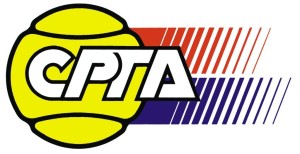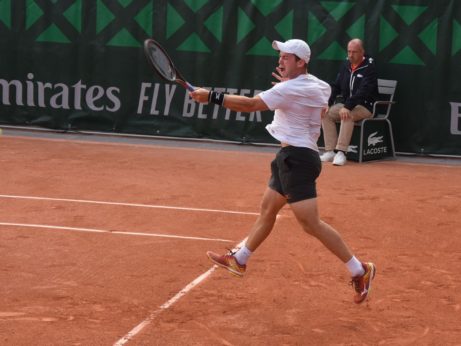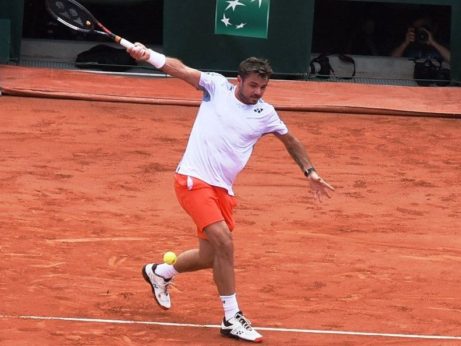Jelena Ostapenko – Powerful Forehand 3.0 from Latvia

In June 2017, the young Jelena Ostapenko (*1997 / LAT) from Latvian Riga came with her surprising 2017 French Open women’s title into the history books as the first ever tennis Grand Slam winner from the country of her birth and as the first unseeded French Open female event winner since the 30’s of the past century. Jelena started with tennis early as she was introduced to the sport my her tennis player turned coach mother Jelena Jakovleva. There can be spotted a certain resemblance with the former world #1 Martina Hingis (*1980 / SUI) who was also introduced to the sport by her tennis player turned coach mother Melanie Molitor. Both mothers have had, mainly because of growing up in the former communist countries, difficulties to succeed in their own playing careers, but they both have learned what’s important for a big success and were able to install this into their respective daughters. It was my personal pleasure being able to bring in some influence and to witness the growth of both of them from quite early stages (Martina from 7 years of age and Jelena from 12 years of age) on.
One of the bases of Jelena’s success is her very powerful forehand, which was clicked as having higher average speed than the forehands of the men’s #1 seed Andy Murray (GBR) during this French Open. Jelena’s forehand (played with a Semi-Western grip) has an excellent foundation with a form of the take-back/backswing, which is bringing the racket into the appropriate hitting position very early. She doesn’t have any potentially disturbing added motions incorporated, which would make adjustments of the racket angle in the last moments necessary. This, together with her almost perfect use of the ground reaction force and a very good eye control of the ball impact area, allows for a very powerful stroke with a full body engagement. The relatively early elbow bend in the follow through is then the risk factor being co-responsible for Jelena’s relatively high percentage of errors.
The below-shown footage of Jelena’s forehand is from her losing first-round 2016 US.Open match against Petra Kvitova (CZE). For comparison, I am showing a 2017 French Open forehand sequence of Timea Bacsinszky (*1989 / SUI), who was in her childhood developed by her Hungarian father Igor Bacsinszky, and whose forehand set-up with an extreme Western forehand grip doesn’t allow for such an early racket angle preparation like in Jelena’s case. Mainly because of that, forehand is mostly Timea’s biggest weakness. Their semi-finals match during the 2017 French Open was won by Jelena in 3 sets. Obviously, this my comparison here has because of the different surfaces and a time lapse a bit limited validity, but it points, in my personal opinion, into the right direction.
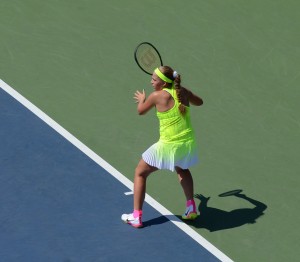
Jelena Ostapenko (*97 / LAT) – Forehand 3.0 in the match – 1 of 6 – full body pivot initiates the preparation – 2016 US.Open – New York
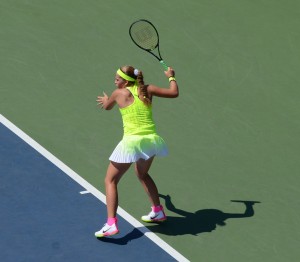
Jelena Ostapenko (*97 / LAT) – Forehand 3.0 in the match – 2 of 6 – backswing 1 with the palm facing to the outside – 2016 US.Open – New York

Jelena Ostapenko (*97 / LAT) – Forehand 3.0 in the match – 3 of 6 – backswing 2 – palm faces the back fence, non-dominant (left) hand points into the direction of the incoming ball – 2016 US.Open – New York
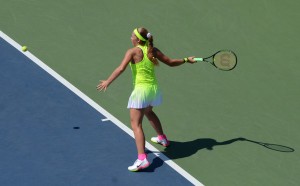
Jelena Ostapenko (*97 / LAT) – Forehand 3.0 in the match – 4 of 6 – push-off with the outside leg, Jelena’s racket is already at the desired angle with the ground – a bit late timing – Jelena, as it seems, focuses on position around the baseline and pays the price with a rather a bit later impact – 2016 US.Open – New York
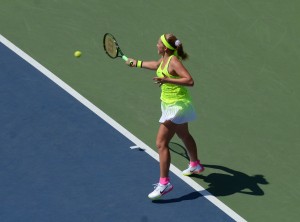
Jelena Ostapenko (*97 / LAT) – Forehand 3.0 in the match – 5 of 6 – just before the impact – perfect eye control of the impact zone – the impact will be a bit too late – 2016 US.Open – New York
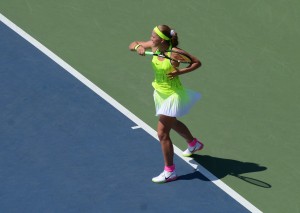
Jelena Ostapenko (*97 / LAT) – Forehand 3.0 in the match – 6 of 6 – end of the follow through 1 with almost full pronation – the rather early elbow bending is from the biomechanical point of view the main factor leading to Jelena’s higher percentage of errors, also elbow problems could occur with a bit higher probability – 2016 US.Open – New York

Timea Bacsinszky (*89 / SUI) – Forehand in the match – 1 of 4 – take-back/backswing 1 with a strong Western grip – the height of the backswing is similar to Ostapenko’s forehand, but the elbow position is different – 2017 French Open – Paris
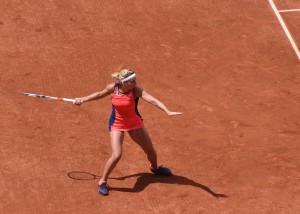
Timea Bacsinszky (*89 / SUI) – Forehand in the match – 2 of 4 – backswing 2/initiation of the push-off, Timea’s racket is almost fully closed and elbow straight, compare to Jelena’s perpendicular racket position and bent elbow at the similar moment shown above – 2017 French Open – Paris
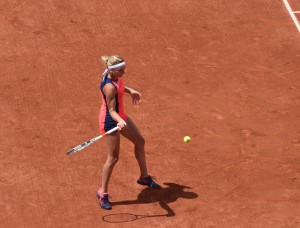
Timea Bacsinszky (*89 / SUI) – Forehand in the match – 3 of 4 – forward swing towards impact, the wrist is practically locked already, but Timea’s racket is still at approximately a 45° angle away from the perpendicular impact position, which makes adjustments in the very last moments before the impact necessary – this stroke form leads to a bit higher forearm muscle pretension (and rather more wrist problems down the road), but also to higher amount of errors and limited stroke versatility to different heights and irregularities of the impact – 2017 French Open – Paris
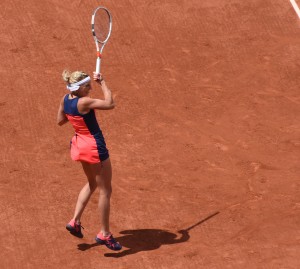
Timea Bacsinszky (*89 / SUI) – Forehand in the match – 4 of 4 – follow through without pronation blocking the full release of the body energy into the stroke, rather Forehand 2.0. Even with such an extreme forehand grip, a more efficient form of the follow through is possible, but Timea seems to be missing the exact knowledge of the therefore needed part of the TENNIS 3.0 CODE – 2017 French Open – Paris

Jelena Ostapenko (*97 / LAT) – defensive open-stance forehand (active defense with a position close to the baseline) in the match – 1 of 2 – short before the impact- perfect eye control of the impact zone, the racket is in the desired angle early, the wrist is locked, the power comes mainly from the push-off and the hip rotation – 2016 US.Open – New York
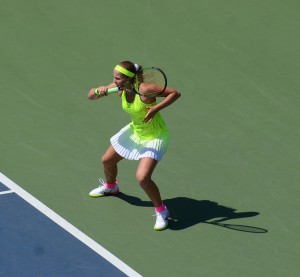
Jelena Ostapenko (*97 / LAT) – forehand in the match – 2 of 2 – end of the follow through 1 – full pronation, well-balanced body, eyes follow the stroked ball, just the rather early elbow bend partly limiting the right shoulder activity can be seen as a risk factor – 2016 US.Open – New York
This article is just a partial stroke analysis focusing on certain stroke elements. More analytic photos and further technical details about both players, as well as improvement suggestions towards higher margin, are available upon request at drmgb11(at)gmail.com.
Photos (August 2016 & June 2017) and text (June 2017) copyright by Dr. Martin G. Baroch. Any further publication of either photos or text with the written permission of the copyright holder/author only!
